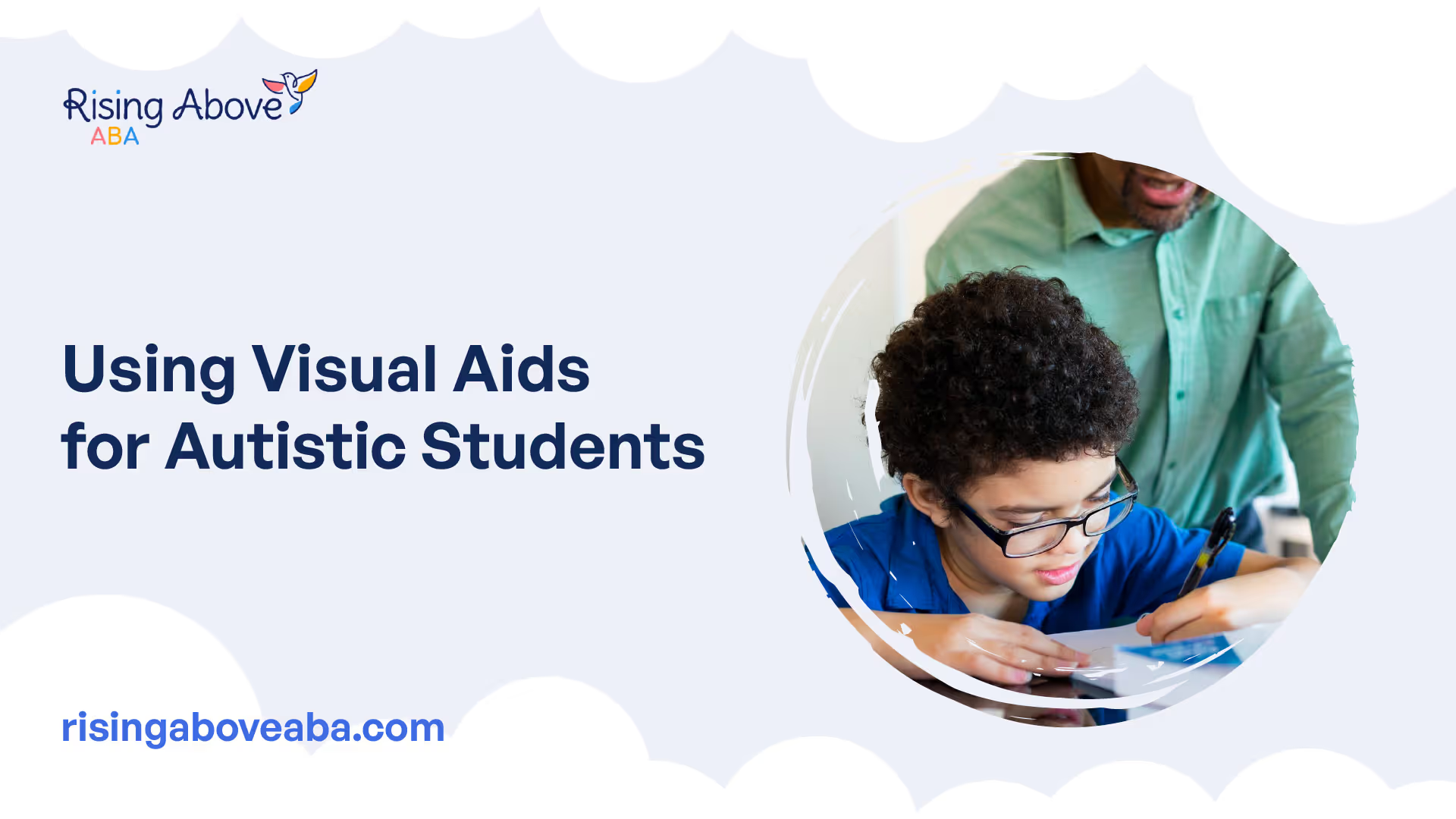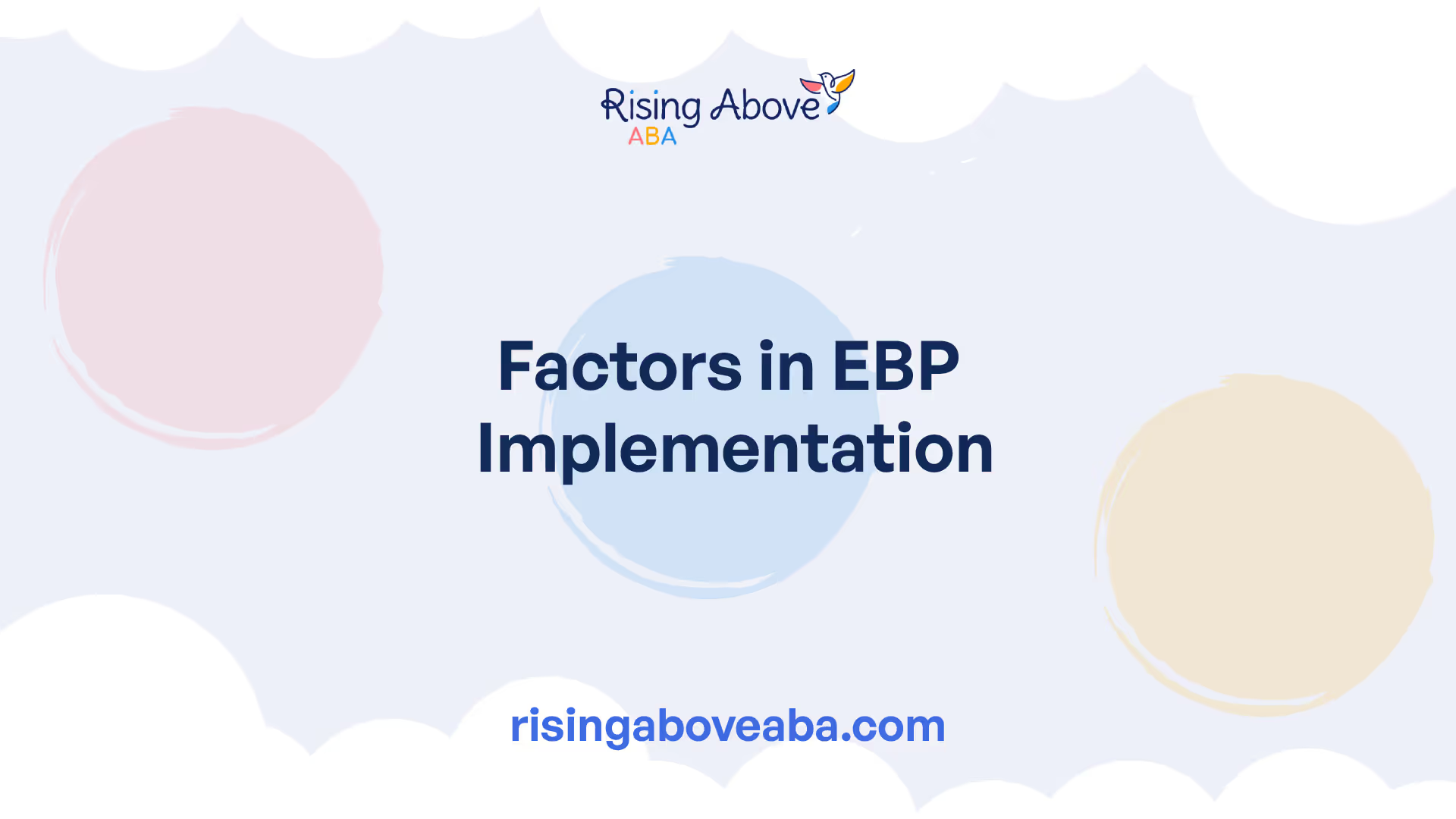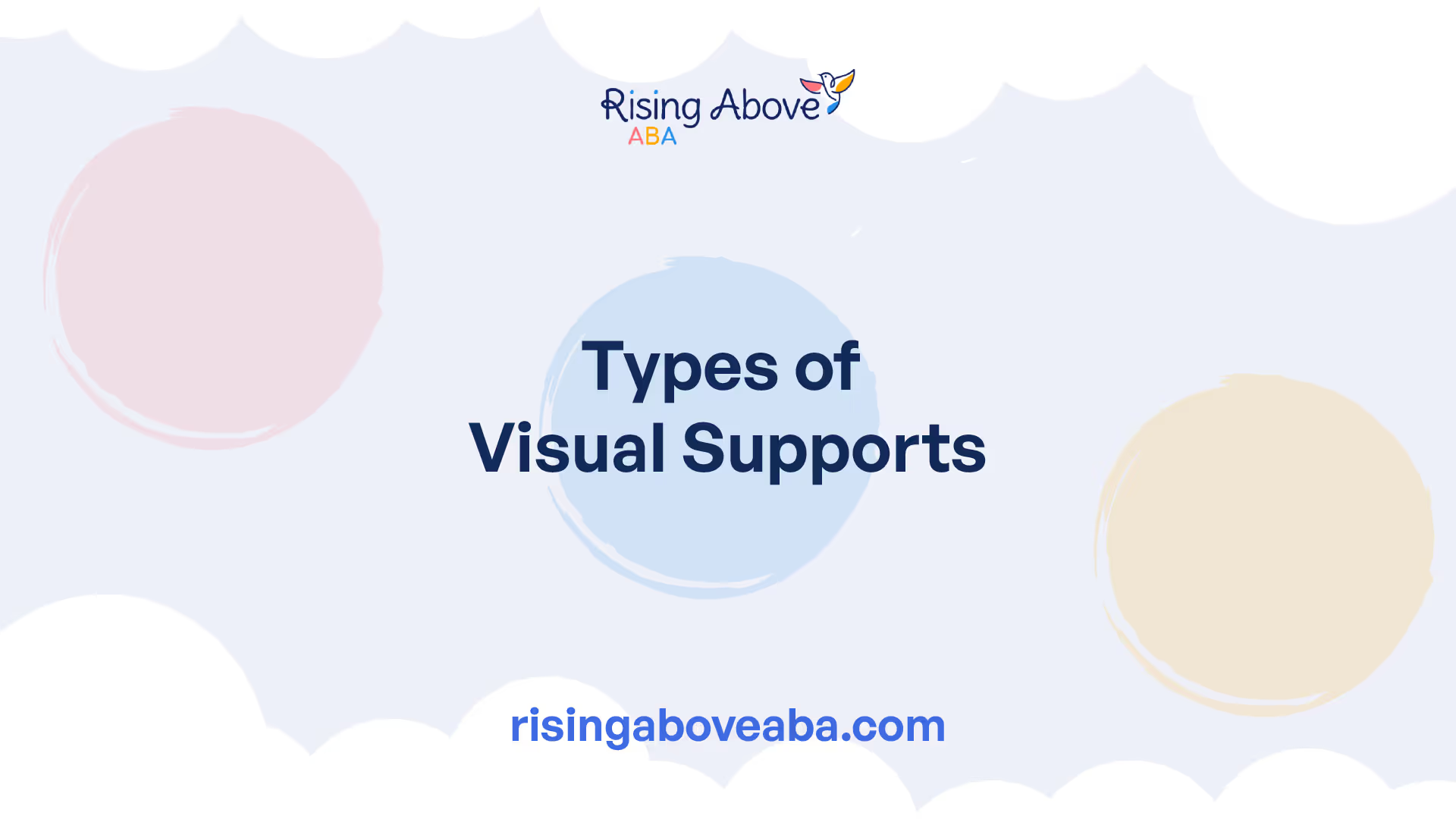Using Visual Aids for Autistic Students
Enhance learning for autistic students with visual aids! Discover effective strategies & benefits of using visual supports.

Implementing Evidence-Based Practices
When it comes to supporting autistic students, it is essential for educators and professionals to implement evidence-based practices (EBPs) that have been proven effective in teaching appropriate behaviors and skills while reducing inappropriate behaviors. Utilizing evidence-based strategies is crucial for ensuring positive outcomes for students with autism spectrum disorder (ASD).

Utilizing Evidence-Based Strategies
The National Professional Development Center (NPDC) on Autism Spectrum Disorder has identified 27 evidence-based practices for improving outcomes for students with ASD. These practices encompass a wide range of interventions, including communication and social skills training, visual supports, and structured teaching methods.
By utilizing evidence-based strategies, educators can provide targeted interventions and support that are tailored to the unique needs of autistic students. These strategies have been carefully researched and have demonstrated effectiveness in promoting skill development and reducing challenging behaviors.
Mandates for Evidence-Based Practices
Educators have a responsibility to use evidence-based academic and behavioral practices to the greatest extent possible. Two federal laws, the Every Student Succeeds Act (ESSA) and the Individuals with Disabilities Education Act (IDEA '04), mandate the use of evidence-based practices and programs to ensure that students receive the most effective interventions available [1].
These mandates underscore the importance of using interventions that have a strong evidence base. By implementing evidence-based practices, educators can provide high-quality education and support that is grounded in research and proven to be effective for students with autism.
To ensure the successful implementation of evidence-based practices, educators should stay informed about the latest research and training opportunities. Ongoing professional development can help educators enhance their knowledge and skills in utilizing evidence-based strategies, ultimately benefiting the educational experience and outcomes of autistic students.
By utilizing evidence-based strategies and adhering to mandates for evidence-based practices, educators can create a supportive and effective learning environment for autistic students. These practices provide a solid foundation for promoting skill development, fostering independence, and maximizing the potential for success. To learn more about supporting autistic students, check out our articles on autism and bullying: prevention and support, enhancing communication for autistic students, and classroom accommodations for autism.
Selecting and Implementing Evidence-Based Practices
When supporting autistic students, it is essential for educators and practitioners to implement evidence-based practices (EBPs) that have been shown to be effective in teaching appropriate behaviors and skills and decreasing inappropriate behaviors for the target population. The National Professional Development Center (NPDC) on Autism Spectrum Disorder has identified 27 evidence-based practices for improving outcomes for students with ASD.
Determining Target Behavior
Before selecting an evidence-based practice (EBP) to implement, educators and practitioners need to determine the specific target behavior they want to address. This involves collecting baseline data and conducting assessments to identify the behavior that needs to be addressed. By understanding the specific challenges and needs of the student, educators can choose an EBP that is most appropriate for that individual.
Setting Goals in IEP/IFSP
Once the target behavior has been identified, it is important to set goals in the individualized education program (IEP) or individualized family service plan (IFSP). These goals should be specific, measurable, achievable, relevant, and time-bound (SMART goals). The goals should align with the target behavior and reflect the desired outcomes for the student. By setting clear goals, educators can track progress and evaluate the effectiveness of the chosen EBP.
Evaluating EBP Effectiveness
After implementing the chosen EBP, it is crucial to evaluate its effectiveness in addressing the target behavior. This evaluation should be ongoing and involve monitoring the student's progress over time. Educators and practitioners should collect data, analyze the results, and compare them to the baseline data collected earlier. If the desired outcomes are not achieved, adjustments may need to be made, such as modifying the EBP or providing additional support.
Considerations for the selection and implementation of EBPs include factors such as the student's characteristics, staff expertise, and available resources. It is important to ensure that interventions are implemented with fidelity, meaning they are delivered as intended. Monitoring the impact of EBPs on student behavior over time allows educators to make informed decisions and make adjustments if necessary.
By following a systematic approach in selecting and implementing EBPs, educators can provide effective support for autistic students and improve their outcomes. It is crucial to tailor interventions to meet the individual needs of each student and regularly evaluate the effectiveness of the chosen practices. For more information on supporting students with autism, consider reading our related articles on autism awareness for teachers and staff, enhancing communication for autistic students, and classroom accommodations for autism.
Factors in EBP Implementation
When implementing evidence-based practices (EBPs) for autistic students, there are several factors to consider to ensure successful implementation and effectiveness. Educators and practitioners play a crucial role in selecting, implementing, and monitoring the chosen practices. Two important aspects to consider are the implementation process itself and ensuring fidelity and monitoring.

Considerations for Implementation
When selecting an EBP to implement, educators and practitioners should take into account various factors to increase the likelihood of success. These considerations include:
- Student Characteristics: It is important to consider the unique characteristics and needs of the autistic student. Each student may respond differently to different interventions, so it's essential to select an EBP that aligns with their specific needs and learning style.
- Staff Expertise: Educators and practitioners should assess their own expertise in implementing the chosen EBP. Training and professional development opportunities can enhance their knowledge and skills, enabling them to effectively implement the practice.
- Available Resources: Adequate resources, including materials, time, and support, are necessary for successful implementation. Educators should assess the availability of these resources and ensure they are sufficient to support the implementation of the selected EBP.
- Collaboration and Communication: Collaboration among educators, practitioners, and other professionals involved in the student's education is crucial. Open and effective communication ensures a coordinated approach and maximizes the chances of successful implementation.
By considering these factors, educators and practitioners can increase the likelihood of successful implementation and positive outcomes for autistic students.
Ensuring Fidelity and Monitoring
To ensure the effectiveness of the selected EBP, educators must focus on fidelity and ongoing monitoring. Fidelity refers to implementing the EBP as intended, adhering to its core principles and procedures. Monitoring involves regularly assessing the impact of the practice on student behavior and progress.
- Fidelity: Educators should strive to implement the chosen EBP with fidelity. This involves following the procedures and strategies outlined in the practice faithfully. Regular training, coaching, and supervision can help maintain fidelity and address any challenges that arise during implementation.
- Monitoring: Monitoring the impact of the EBP on student behavior over time is essential. Educators should collect data on the student's progress and compare it to the goals set in the individualized education program (IEP) or individualized family service plan (IFSP). If the desired outcomes are not achieved, adjustments may be necessary, such as modifying the intervention or providing additional support.
By ensuring fidelity and monitoring the effectiveness of the chosen EBP, educators can make informed decisions and make necessary adjustments to support the progress and development of autistic students effectively.
Implementing evidence-based practices requires careful consideration of the implementation process and ongoing fidelity and monitoring. By taking these factors into account, educators and practitioners can enhance the effectiveness of interventions and provide meaningful support for autistic students. For more information on autism support in schools, check out our related articles on autism and bullying: prevention and support, enhancing communication for autistic students, and classroom accommodations for autism.
Importance of Visual Aids
In the realm of supporting autistic students, visual aids play a crucial role in enhancing communication, comprehension, and overall learning experience. These aids, such as pictures, drawings, charts, graphs, and diagrams, are effective tools for conveying information to individuals with varying levels of literacy and numeracy skills. Let's explore the effectiveness and benefits of using visual aids for autistic individuals.
Effectiveness of Visual Aids
Visual aids have been proven to be highly effective in facilitating understanding and retention of information for individuals on the autism spectrum. The visual nature of these aids appeals to the visual strengths often found in autistic individuals, making information more accessible and comprehensible. By presenting information in a visual format, complex concepts can be simplified and made more tangible.
Furthermore, visual aids help to structure information and provide a visual framework for organizing thoughts and ideas. This aids in improving focus and attention, enabling autistic students to better process and comprehend information. Visual aids can also assist with memory recall, as the visual representation acts as a visual cue, triggering retrieval of information.
Benefits for Autistic Individuals
The benefits of visual aids extend beyond improved comprehension. Visual supports provide structure and routine, fostering predictability and reducing anxiety for autistic individuals. They offer a tangible representation of the sequence of activities, helping individuals understand and navigate daily routines more independently.
Visual aids also play a significant role in enhancing communication skills. They can serve as a bridge between individuals with autism and their caregivers, facilitating understanding and promoting meaningful interactions. Tools such as Picture Exchange Communication System (PECS) cards expand a child's ability to interact with their surroundings and provide a sense of autonomy.
Additionally, visual schedules and timetable cards assist children with autism in comprehending the rhythm of their day, preparing for transitions, and providing stability in their routines. By having a visual representation of their daily activities, individuals with autism can actively participate in decision-making and develop a sense of control over their own lives [3].
The use of visual aids in supporting autistic students is not only effective but also has a positive impact on their overall well-being and quality of life. Research has shown that a home-based visual supports intervention resulted in improved parent-reported quality of life, increased access to resources, and enhanced confidence in using visual supports at home. These findings highlight the significance of incorporating visual aids as part of a comprehensive support system for autistic individuals.
Visual aids provide a powerful tool for supporting autistic students by enhancing communication, fostering independence, reducing anxiety, and promoting understanding. By leveraging the benefits of visual supports, educators and caregivers can create an inclusive and supportive environment that empowers autistic individuals to reach their full potential.
Types of Visual Supports
Visual supports are powerful tools that can greatly benefit autistic students in the classroom. They provide visual cues and aids to help with communication, understanding, and organization. Let's explore the range of visual tools available and the various ways they can be used to support autistic students.

Range of Visual Tools
Visual aids come in various forms, each serving a specific purpose in assisting autistic students. These tools include:
- Pictures and Drawings: Visual representations in the form of pictures or drawings can help convey information and concepts more effectively. They can be used to illustrate schedules, routines, and social stories, making abstract concepts more tangible and easier to understand.
- Charts and Graphs: Visual representations of data using charts and graphs can help autistic students comprehend and interpret information more easily. These visual aids can be used for tasks such as tracking progress, visualizing schedules, or representing data in a more accessible format.
- Diagrams and Visual Organizers: Diagrams and visual organizers provide a structured format for organizing information. They can be used to break down complex tasks or concepts into smaller, more manageable components, facilitating understanding and problem-solving.
- Visual Schedules and Timetables: Visual schedules and timetables provide a clear and predictable structure for autistic students. These aids help establish routines, reduce anxiety, and enhance independence by visually representing what activities or tasks will occur and in what sequence.
- Social Stories and Comic Strip Conversations: Social stories and comic strip conversations use visual formats to teach social skills, promote social understanding, and facilitate communication. They provide step-by-step narratives with visual cues to help autistic students understand social situations and appropriate responses.
Ways to Use Visual Supports
Visual supports can be implemented in various ways to cater to the individual needs of autistic students. Here are some common methods of using visual supports:
- Daily Timetables: Creating visual timetables that outline the sequence of activities throughout the day helps autistic students understand and anticipate what will happen next. These timetables can be displayed prominently in the classroom, providing a visual reference for students to refer to.
- Schedules and Sequences: Visual aids can be used to break down tasks or activities into sequential steps. This helps autistic students follow along and understand the order of actions required to complete a task or navigate a routine.
- Reward Charts: Visual reward charts can be used to encourage positive behavior and motivate autistic students. These charts visually track progress and provide a visual representation of the rewards students can earn through their efforts.
- Making Choices: Visual supports can assist autistic students in making choices by presenting options visually. This allows them to understand and express their preferences, promoting independence and self-advocacy.
- Illustrating Social Stories: Social stories, which explain social situations and appropriate behaviors, can be enhanced with visual aids. The combination of visual cues and written narratives helps autistic students better understand and navigate social interactions.
It's important to note that visual supports should be personalized to meet the unique needs of each autistic student. What works for one individual may not work for another. Additionally, it is recommended to introduce visual supports gradually, starting with one symbol or aid, and then gradually building up a collection to avoid overwhelming the student [5]. By using a combination of visual tools and techniques, educators can effectively support autistic students in their learning journey.
Best Practices for Visual Supports
When it comes to using visual aids for autistic students, there are some best practices to consider. These practices help ensure the effectiveness and successful implementation of visual supports in the educational setting.
Making Visual Supports Personalized
Visual supports are highly individualized, and what works for one autistic student may not work for another. It is crucial to make visual supports personalized to meet the specific needs and preferences of each student. This can be done by considering the student's interests, sensory preferences, and communication style.
Here are some strategies for personalizing visual supports:
- Use familiar images: Incorporate visuals that are familiar and meaningful to the student. This could include using photographs of the student, their family, or their favorite objects.
- Consider sensory preferences: Take into account the student's sensory preferences when selecting visual materials. For example, some students may respond better to visual supports with bright colors, while others may prefer more muted tones.
- Incorporate the student's interests: Use visuals related to the student's interests to increase engagement and motivation. For example, if a student is passionate about animals, incorporate visuals of animals into their visual supports.
By personalizing visual supports, educators can ensure that they are meaningful and relevant to the individual student, increasing their effectiveness and promoting engagement.
Gradual Introduction of Supports
Introducing visual supports gradually is an important aspect of their successful implementation. Starting with one symbol or visual aid and gradually building up a collection allows students to become familiar with the supports and learn how to use them effectively.
Here are some steps to consider when introducing visual supports:
- Assess the student's needs: Determine the specific communication and support needs of the student. This will help identify which visual supports are most appropriate and relevant.
- Start with one symbol or visual aid: Begin by introducing one symbol or visual aid that targets a specific communication or behavioral goal. This allows the student to become familiar with the support and understand its purpose.
- Provide modeling and reinforcement: Model how to use the visual support and provide reinforcement when the student successfully utilizes it. This helps reinforce the connection between the visual support and the desired behavior or communication.
- Gradually add more supports: Once the student has grasped the use of one visual support, gradually introduce additional supports based on their needs. This could include visual schedules, choice boards, or social stories.
By gradually introducing visual supports, students have the opportunity to learn how to use them effectively and develop independence in their use. It also allows educators to assess the impact of each support and make adjustments as needed.
Implementing these best practices for visual supports can greatly enhance communication and support for autistic students in the classroom. By personalizing the supports and introducing them gradually, educators can create a supportive learning environment that promotes engagement, independence, and success. For more information on supporting autistic students, check out our articles on autism awareness for teachers and staff and classroom accommodations for autism.
References
- [1]: https://iris.peabody.vanderbilt.edu/module/asd2/cresource/
- [2]: https://www.cdc.gov/healthliteracy/developmaterials/visual-communication.html
- [3]: https://www.autismparentingmagazine.com/benefits-of-autism-visual-supports/
- [4]: https://www.ncbi.nlm.nih.gov/pmc/articles/PMC10001844/
- [5]: https://www.autism.org.uk/advice-and-guidance/topics/communication/communication-tools/visual-supports

Compassion. Communication. Positivity. Professionalism
Give us a call at 888.572.7473 or reach out to our team online to get started—we're looking forward to partnering with your family.
Latest articles






Reach Out to Rising Above ABA

Most commercial insurance accepted
Contact us for any questions regarding coverage or plans – we’ll be happy to provide you with the clear guidance as to your best options.


